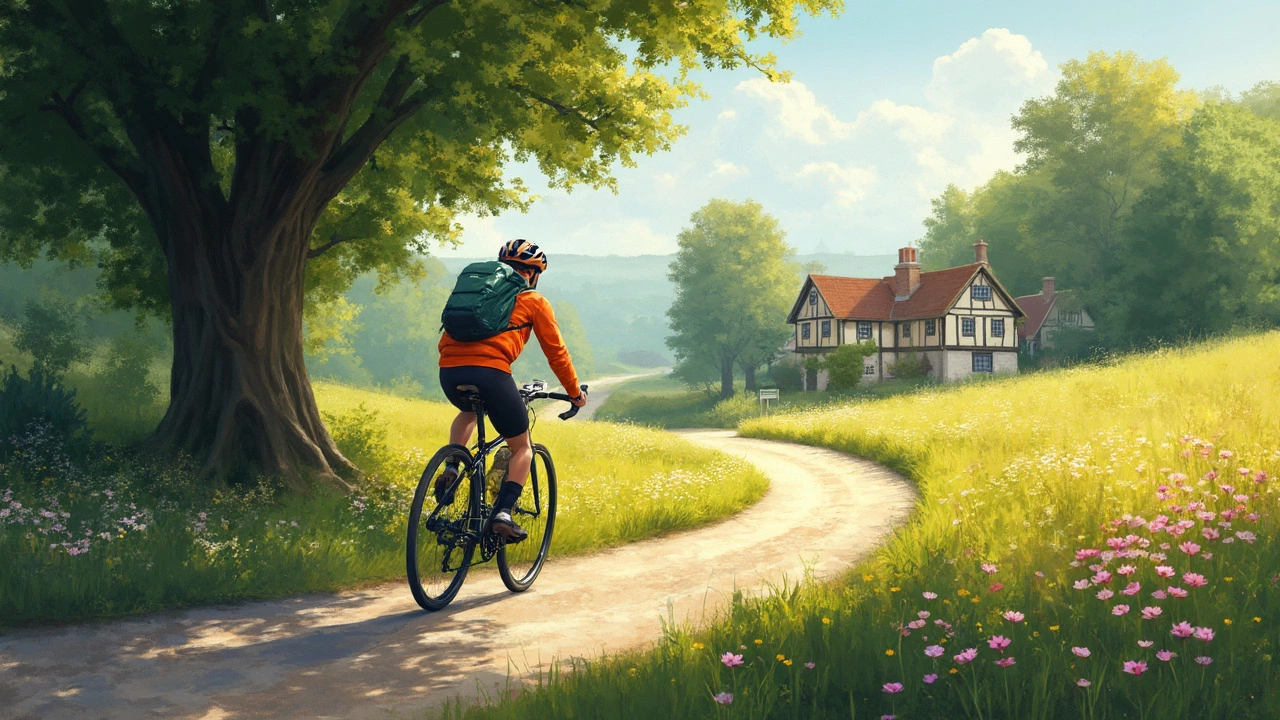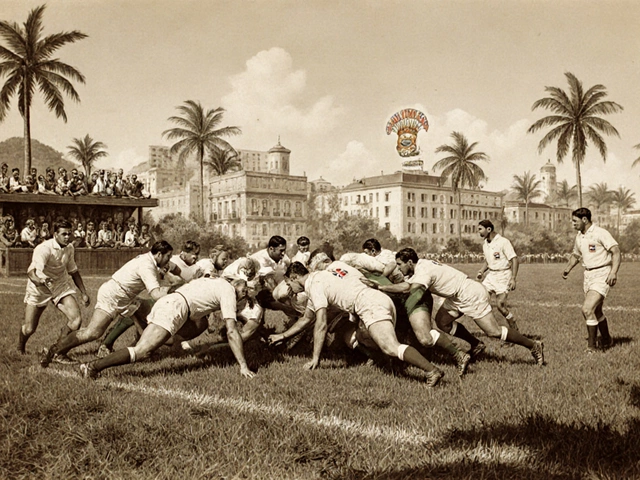
Cycling April 13, 2025
Cycling Speeds on Google Maps: How Fast Are You Really Going?
Have you ever used Google Maps for a cycling trip and felt like it misjudged how fast you really pedal? You're not alone, buddy. Google Maps sets the average cycling speed at around 16 km/h (roughly 10 mph) to plot your ride. While this might be spot on for some, it could be a bit off for others, especially if you're the next Tour de France hope or just taking it easy on a weekend jaunt.
This speed isn't pulled from thin air, though. It's Google's way of balancing between slow starters and speed demons. Still, if you're in a hurry or on a leisure stroll, it's handy to know what Google's serving up in terms of biking speeds. It helps you manage expectations—whether you're catching a train or just don't want to be late for brunch.
- Default Cycling Speed on Google Maps
- Factors Affecting Google's Assumed Speed
- Personalizing Your Cycling Experience
- Comparing Google Maps with Other Platforms
- Ways to Improve Your Cycling Time
- Top Tips for Using Google Maps for Cycling
Default Cycling Speed on Google Maps
So, what speed does Google Maps use for cycling? On average, it assumes a cycling speed of about 16 km/h (or around 10 mph). Now, this isn't just some random number thrown into the algorithm. It's a carefully considered speed that balances a lot of factors, like different fitness levels, types of bikes, and cycling conditions. This seems to be a sweet spot for many casual and commuter cyclists.
But why 16 km/h? For most folks cycling through cities or quiet towns on their usual bike, this speed makes sense. You might be zipping along faster on a smooth path with no stops, but factor in stuff like traffic lights and tricky turns, and this average speed provides a reasonable estimate for travel times. Still, it may not always match real-world conditions due to things like hills or adverse weather.
If you're cycling through hilly paths or urban jungles, your speed might flip unexpectedly. But having a baseline speed provides a starting point for Google Maps to calculate how long it might take to get from A to B. It's not about pinning your average speed down precisely—it's about getting a ballpark figure to plan your trip better.
Now, if you're using Google Maps for something more than a Sunday afternoon cruise, like racing to work or a timed challenge, 16 km/h might not cut it. You might find your pace significantly different and that’s why familiarizing yourself and adjusting for your personal pace is something to consider.
Overall, Google's default cycling speed provides a useful guideline for most riders, though it may require some personal tweaking for those with specific needs. It's all about knowing your style and adjusting accordingly.
Factors Affecting Google's Assumed Speed
So why does Google Maps peg cyclists at around 16 km/h? Well, several things play into this digital estimate, and it's not just a roll of the dice. The algorithm considers stuff like typical city environments, where traffic lights and pedestrian crossings slow you down. It's meant to reflect an average cyclist rather than competitive racers or leisurely riders.
One big factor is the terrain. Google Maps uses data on elevation changes to tweak the speed assumption. Hills can seriously impact how fast you go. You're probably not zipping up steep inclines as you do on flat roads. Also, the type of road matters—busy streets with lots of stops will naturally mean slower average speeds.
Cycling speed can also swing based on weather conditions. Wind resistance, rain, or snow can have you pumping the brakes more than you'd like. “Factors like environmental conditions and physical fitness substantially change travel time,” mentioned Dr. Amelia Woods, a transport analyst, in a recent interview.
"Biking through downtown during peak hours or on a sunny Sunday morning will change the journey time," pointed out Dr. Woods.
Important too are personal elements: how fit are you feeling, the type of bike you're using, and even time of day. Night rides might be slower due to visibility concerns or personal caution.
To keep it all streamlined, Google looks at past data from users who travel along the same paths and injects a bit of this historical data to fine-tune and provide more accurate time estimates. Still, it helps to know where a bit of wiggle room lies so you can plan better and not have to pedal like mad to catch that meeting!
Personalizing Your Cycling Experience
Alright, so Google Maps doesn't always nail the exact speed for every cyclist, but don't worry, you can still make your ride more tailored to your style. Getting the best out of Google Maps for cycling might mean taking the wheel yourself, so to speak.
A cool way to personalize your ride is by using features like the avoid highways option. This way, you're more likely to stick to scenic routes or quieter paths, which can totally change your cycling vibe.
Ever heard of using personalized settings to adjust average speeds on maps? Some cycling apps let you choose your average speed to better match your actual pace. For example, Strava offers functionalities where you can set your expected pace, giving you a more accurate ETA for your rides.
"The more customizations you can make to your cycling routes, the better your navigation tools can fit your personal experience," says John Stevens, a well-regarded cycling coach.
Unfortunately, Google Maps itself doesn't yet support speed adjustments, but combining its navigation with apps like Strava or Komoot can be a game-changer.
- Use Strava's pace settings to adjust your predicted speed.
- Enable "avoid highways" to find quieter paths.
- Check weather conditions that might impact your ride time.
- Combine Google Maps with other cycling apps for enhanced features.
One thing many riders overlook is the impact of external conditions on their expected speed. Wind speed, the type of terrain, and even urban traffic lights play a huge role in how fast you'll get somewhere. Understand these factors to better gauge your actual travel time.
So, while Google might have a one-size-fits-all approach, with a little app mixing and some common sense, your cycling experience can be as unique as you are. Keep in mind that personalizing your experience can lead to not just a better ride, but a safer one too.

Comparing Google Maps with Other Platforms
When it comes to planning your bike ride, Google Maps is just one of many tools available. But how does it stack up against competitors like Strava and Komoot? Let's dive into the nitty-gritty to see the differences.
Google Maps is often seen as the go-to for quick directions because it's straightforward and usually already on your phone. It provides decent basic info like estimated travel time, distance, and even elevation.
But if you're a data junkie or live for the thrill of challenges, you might find Google Maps a bit bland. Platforms like Strava and Komoot offer more detailed analytics and social features. Strava, for instance, is fantastic for tracking not just speed and distance, but also for competing with friends or even strangers over certain cycling segments.
In contrast, Komoot shines in route planning. It's great for adventure seekers who love exploring new terrains and want a tailor-made cycling experience. Komoot considers different surfaces, offering a choice between paved roads or dirt tracks, perfect for mountain biking enthusiasts.
Below is a quick comparison of key features:
| Feature | Google Maps | Strava | Komoot |
|---|---|---|---|
| Routing | Standard | Community-driven | Customizable |
| Tracking | Basic | Detailed | Detailed |
| Social Features | Limited | Extensive | Somewhat interactive |
So, while Google Maps might be the fastest option for everyday use, if you're serious about cycling and crave more functionality, it's worth exploring these other platforms. Match your tool to your needs, whether it's racing against the clock or savoring a leisurely Saturday ride through new paths.
Ways to Improve Your Cycling Time
Alright, let’s talk about getting faster. Whether you're trying to beat Google Maps' cycling speed or just want to cut some time off your daily ride, there are a few tricks you can throw into your biker's toolkit.
- Tune Your Bike: Start by ensuring your bike is in tip-top shape. A well-oiled chain and properly inflated tires can make a world of difference, helping you ride smoother and faster.
- Pacing Yourself: It’s not just about bombing it out on the road. Learn to pace yourself. Start by riding at a sustainable speed and build up gradually. This helps conserve energy, giving you more speed in the long run.
- Plan Your Route: Using Google Maps or another cycling app, try to choose routes with fewer stops and less traffic. Less stopping means you maintain momentum, which is key to cutting down travel time.
- Windy Days: Keep an eye on the weather, especially the wind. If possible, plan your route to have a tailwind rather than a headwind, especially on the return journey when you might be more tired.
- Interval Training: To genuinely increase your speed, incorporate interval training into your rides. Short bursts of speed followed by recovery help improve your endurance and overall speed.
Here’s a handy stat — consistently maintaining a speed of 20 km/h rather than the typical 16 km/h can shave travel time by 20-30% on many routes. That could mean getting home 10-15 minutes faster! Not bad, right?
Lastly, remember riding with a group can encourage you to push a little harder, and biking buddies make everything a bit more fun. Hey, maybe together you can blow Google Maps’ speed assumption out of the water!
Top Tips for Using Google Maps for Cycling
So, you're ready to hit the road with your bike and want to make the most out of Google Maps? Let's make your ride as smooth as possible. Here are some handy tips to keep you rolling like a pro.
- Check the Terrain: Before setting off, take a good look at the route details. Google Maps will outline the elevation changes so you know if you're facing a flat path or a few challenging hills.
- Use Street View: Wondering about the path surface or looking for landmarks? Street View can give you a sneak peek, which comes in especially handy if you're navigating busy intersections.
- Plan for Pit Stops: Whether it's a coffee stop or a bathroom break, throw in some extra time for rest along your route. Google Maps lets you search for nearby cafes or restrooms to include in your journey.
- Save Maps Offline: Signal drops are the last thing you need during a ride. Download the map of your route beforehand so you're covered, even if your phone decides to take a break.
- Customize the Route: Not all suggested routes are ideal for everyone. You can drag and drop to customize your path. Want to avoid traffic? Google Maps lets you bypass the main roads.
- Check for Updates: Traffic and road conditions change, so use real-time updates from Google Maps to adjust your route and timing as needed.
Google Maps is a stellar tool for cyclists, offering lots of customization to make sure you get from A to B in the best way possible. Next time you saddle up, use these tips to make your ride more enjoyable and efficient.




